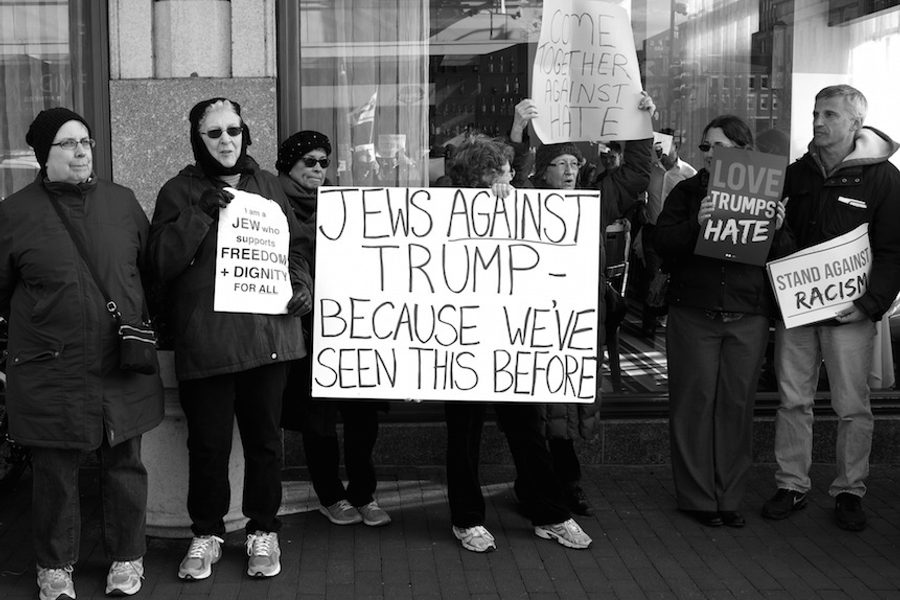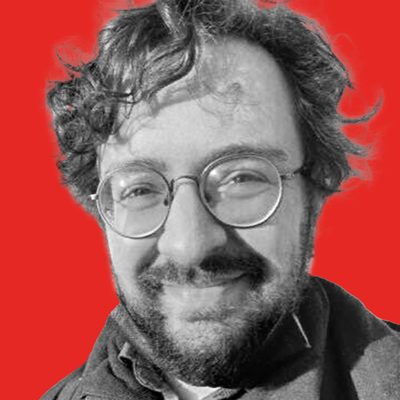In the Age of Trump, Progressive Jews Can Learn From the 20th Century’s Radical Yiddish Tradition
Our forebears’ struggles against capitalism, fascism and Zionism—carefully chronicled in Revolutionary Yiddishland—resonate more than ever now that the the far right is once more taking power.
Ben Lorber

The official, textbook history of any nation or group of people, writes radical historian Howard Zinn in A People’s History of the United States, can be sure to conceal “the fierce conflicts of interests, sometimes exploding, often repressed, between conquerors and conquered, masters and slaves, capitalists and workers, dominators and dominated. … In such a world of victims and executioners, it is the job of thinking people not to be on the side of the executioners.”
Acording to Zinn, it is the task of the radical historian not merely to recount the events of the past with the disinterested, depoliticized gaze of an “objective” academic. We need a history, rather, that lets the marginalized and oppressed voices of the past speak, that listens to these voices so as to distill new lessons, perspectives and imperatives urgently needed to face the political reality of the present.
Revolutionary Yiddishland: A History of Jewish Radicalism, written by Alain Brossat and Sylvie Klingberg, attempts to write such a subversive and relevant history. First published as Le Yiddishland révolutionnaire in 1983 and re-released this November in a first-ever English translation by Verso with new editorial notes, references and an introduction by the translator David Fernbach, the book deals with the generation of Jewish radicals in Eastern Europe who, in the first half of the 20th century, helped raise the banner of world revolution against the terrifying forces of capitalism and fascism. A haunting, inspiring and often tragic book, Revolutionary Yiddishland uses first-hand interviews, deep archival research and sharp analysis to bring to life a complex landscape of factory workers, partisans, poets, party leaders, refugees, ghetto fighters and movement intellectuals.
Released on the day of Donald Trump’s election, the book’s timing of could not be more appropriate. Today, we see clouds of fascism disturbingly analogous to those of a century ago darkening our own political landscape, driven by a toxic and too-familiar collusion of xenophobia and scapegoating, authoritarianism and far-right nationalism, liberal capitulation and corporate mega-profit.
The Radical Jews of Yiddishland
In the late 1800s, millions of Jews living across Eastern Europe left their rural villages, called shtetls, and sought work in the new industrial factories crowding cities like Minsk and Vilna. Before long, this Jewish proletariat birthed a militant trade union movement with messianic intensity. The largest of these mass organizations, the Algemeyner Yidisher Arbeter Bund, or the Jewish Workers Bund, sought to unite all Jewish workers into a socialist party that demanded, in a revitalized Yiddish tongue, equal civil rights and freedom from discrimination for Jews and all workers, an end to class oppression, and a new Russia founded upon democratic socialism and cultural and religious freedom.
As the book recounts, these radical Jews created a new, socialist Jewish culture that brought secular Yiddish theatre, literature, discussion groups, educational systems and other vibrant and democratic institutions to a Jewish world in upheaval. This is the beating heart of Yiddishland — a word which, for the authors, conjures at once the region of Eastern Europe, the Yiddish culture and radical spirit of the Jews who lived there, and the historical moment itself, the dynamic and terrifying 20th-century arc upon which their lives unfolded.
Revolutionary Yiddishland traces how, as the Russian Revolution overthrew the tsar and brought the Bolsheviks to power in 1917, many Yiddishland radicals helped drive the wave of revolutionary enthusiasm that swept Western and Eastern Europe. They helped build left parties, socialist governments and, in many cases, Jewish wings of these and other movements across the continent.
Meanwhile, the nationalist ideology of Zionism, popular among middle-class Jews in Western Europe, also began to make inroads in Yiddishland. The book unearths the passionate arguments between, on the one hand, those Jewish Communists and Bundists who insisted on staying and fighting as part of broad-based grassroots movements in Europe, and, on the other hand, those left-wing Zionists who struggled to fuse their aim of world revolution with their attraction toward a Jewish national home in Palestine.
Later, the book shows how, as fascism spread across Europe, the revolutionaries of Yiddishland fought falangists in 1930s Spain, formed self-defense militias in Nazi-occupied countries like France, organized underground networks of resistance in ghettos like Warsaw, and launched covert campaigns of sabotage and attack as partisans hiding deep behind enemy lines. Finally, we witness the utter liquidation of Yiddishland in the ovens, battlefields and mass graves of Nazi terror. We see its few survivors struggle, and often fail, to maintain their revolutionary spirit in a post-war world that was too quick to suppress and stigmatize the trauma of their destruction, and too eager to denounce their radicalism in the name of realism, or Zionism, or liberalism.
Though Yiddishland traces dense political trajectories across a broad historical arc, it is grounded in a fabric of human experience that makes these narratives anything but abstract. The authors, who in the 1980s conducted extensive interviews with survivors, offer vivid, intimate glimpses into the beating heart of a vanished world.
In the grueling sweat of the factory, we see young workers replace Torah and Talmud with the Communist Manifesto, and convince their religious parents to join them in the fight for a new Messiah. In the crowded working-class neighborhoods of Białystok, we see struggling Jewish families rejoice in the discovery of new literature and theatre that speaks to their own troubles and aspirations, in their own proud Yiddish tongue. On the frenzied streets of revolutionary Russia, we watch patrols of Jewish workers battle tsarist soldiers and chase spies away from meeting houses. On a Yom Kippur night in early 1940s Moscow, we listen as worried Jewish refugees from Poland huddle with their Russian Jewish comrades outside a synagogue, trading terrifying rumors of the ovens at Auschwitz, narrating heroic tales of resistance from the Warsaw Ghetto.
These stories, and so many others, jostle together in the crowded pages of Yiddishland, the faces of the protagonists gazing from the past asking us, if not to avenge their death, at least to remember their life. And Yiddishland does just that, in a stark, refreshing prose that does not glorify these fighters in any “cult of great Heroes,” or idealize them as larger-than-life martyrs.
Rather, the book portrays what it calls a “resistance of the shadows” made of ordinary people who, in extraordinary times, dedicate themselves “without hesitation” to a gritty, uncertain struggle to survive with dignity. The texture of their resistance is not romantic but brutal, often marked by “hunger and fear, missed encounters, tiresome tasks, boredom and greyness, pain and anguish.” And while Yiddishland tells a specifically Jewish story, it opens a first-hand window into the larger movements for political emancipation, working-class empowerment and resistance to fascism that made the 20th century so momentous, and terrifying, for the whole human race.
Why Study Yiddishland Today?
As the authors of Yiddishland detail, a vast, seemingly unbridgeable gulf separates the world of these radicals from our world today. Put simply, German fascism erased their existence from the face of the planet, and uprooted the language, customs, history, cuisine, institutions, religion and economic life of the world that they called home.
How does the Left as a whole view its own past today, ninety-nine years after the Russian Revolution helped usher in a near-century of powerful socialist, leftist, anti-imperialist and other movements that shook the planet? We view these movements mostly as anachronisms of a bygone era — flawed and failed, if well-intentioned and inspiring.
But we have yet to find new forms of resistance capable of challenging and dismantling a rapacious and rampant 21st century global capitalism. As the authors of Yiddishland make clear in their introduction, the larger Left today, like radical Jews, has yet to process and mourn the twists and turns of its recent history. We cannot help but look upon the passionate, almost messianic optimism of early-20th century radicals with a strange sense of dislocation and longing.
In the Jewish imagination today, the memory of the revolutionary Jews of Yiddishland is suppressed, or at most, consumed as a pale imitation. In its absence, the ideology and historiography of Zionism places the creation of Israel at the pinnacle of Jewish history, and portrays the millennia that Jews lived in diaspora, amongst the peoples of the world, as a cycle of permanent suffering, plagued by an eternal anti-Semitism.
In the hegemonic narrative shared and co-created, to some extent, by most Jewish communities in both America and Israel, the memory of the revolutionary Jew of Yiddishland is an image held dimly, and with warmth and pride. But, so the narrative continues, this history’s bitter lesson is that Yiddishland values of solidarity and revolution did not protect even these Jews from Hitler, and that only the Jewish state of Israel can provide the haven of safety, security and identity needed for Jews to exist in the world today.
Even most Jews on the radical left today scarcely remember the names of the radical Jews of Yiddishland. With mere traces of remembrance, we have yet to give them a proper burial, to learn what they yearn to teach us, to know exactly what we, today, have inherited or have yet to inherit from them. Meanwhile, the state of Israel’s 68-year old assault on Palestinian land and life continues at a dizzying rate, and American Jewish support for the Israeli regime continues to lure us onto the wrong side of history, like a collective nightmare from which our community cannot yet awaken.
A New Yiddishland?
It is highly fitting that Revolutionary Yiddishland appears today in English, just as a new radical Jewish movement is emerging here in America, the largest global Jewish population center since Yiddishland itself (slightly edging out Israel by some estimates). Today, more American Jews than ever are joining and building movements against Israel’s occupation and apartheid. Meanwhile, across a thousand spheres of Jewish communal life, progressive movements are forming which seek to hold our many institutions and leaders accountable to the racial and economic justice struggles around and within which we as Jews live. In my work as Campus Coordinator with Jewish Voice for Peace, a national organization inspired by Jewish tradition to stand for justice in Palestine and against all forms of racism, I see this new Jewish identity being built by student activists on college campuses every day.
One hundred years later, with the state of Israel and its right-wing allies in the U.S. finding clear common ground with Donald Trump and neofascist forces worldwide, little has changed since the radicals of Yiddishland organized against capitalists and fascist collaborators in their own community, and denounced Zionism as a bourgeoisie, nationalist movement that allied itself with imperial interests and ruling elites, and cared little for the real struggles of poor and oppressed Jews and non-Jews around the world.
But if this burgeoning movement may be symbolically called here a “new Yiddishland,” it must be stated that this new movement is hardly Yiddish. In a porous, multicultural America, while many Jewish radicals trace their roots to the shtetl, many others inherit traditions from the many non-European Jewish communities of the Middle East, North Africa, Asia and elsewhere, and from non-Jewish ancestors as well. There are other important differences between past and present: While the radical Jewish identity of Yiddishland was forged in direct struggle against class exploitation and violent anti-Semitism, many, though certainly not all, American Jews today benefit from some degree of race and/or class privilege. While yesterday’s Jewish radicals were staunch atheists, today many of us embrace prayer, ritual and spiritual identity infused with, and inseparable from, our radical politics and lives.
It is also appropriate that Revolutionary Yiddishland appears today as a resource for the Left as a whole. As neoliberal capitalism maintains its destructive grip and delivers misery to most inhabitants on the planet, the Left faces a terrifying fascist threat unseen since the era of Yiddishland, with the rapid embrace of far-right politics engulfing Europe and culminating, last week, with the startling seizure by Donald Trump of the most powerful political position in the world. As we combat mounting attacks on Muslim and Arab communities, black folks, immigrants, Jews, women, LGBTQ folks and more, we have much to learn from the boundless optimism, the fearless advances and the terrifying retreats of those who struggled before.
We need to draw hope from this previous generation of radicals who believed, against all odds, that a new sun was dawning in the sky of history. Revolutionary Yiddishland lets this generation speak, and helps us to listen. Through this radical act of remembrance — and through continuing, in our own time, the struggles they were not able to see to victory — we inherit their fight, we redeem their loss, we ensure their death was not in vain. And we relearn, in a new way, that vital lesson expressed in a saying of the ancient rabbis: “It is not incumbent upon you to complete the task, but neither are you free to desist from it.”








